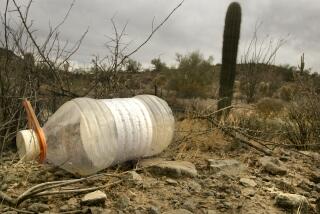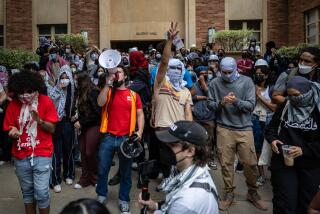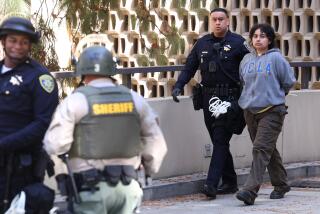CRISIS IN THE PERSIAN GULF : Peace Pilgrims Camp on Honeymoon Island : Activists: Their Baghdad base is a locale favored by newlyweds. Their goal: speaking out against war.
- Share via
BAGHDAD, Iraq — Jon Petter Oie, a pudgy Norwegian businessman and rolling stone, seemed certain why he had come to Baghdad.
“This situation is very dangerous,” he told a reporter over the weekend on the grounds of Iraq’s newly opened World Peace and Friendship Camp. “It demands action. This could be the start of World War III. This is a good opportunity to speak for peace.
“When will your article appear so I can get a copy?”
It takes all kinds to form a peace movement, and Oie is a beginner. Nevertheless, the Iraqi government has taken him in, along with a rotating group of 20 to 30 other foreigners who want to spread the message of a peaceful solution to the Persian Gulf crisis.
Their presence here is hailed by Iraqi officials as proof of international support for President Saddam Hussein’s policies, even though most of the activists say they are not taking sides in the gulf confrontation.
They know why they are in Baghdad--to testify for peace--but they are not quite sure how they ended up in the World Peace and Friendship Camp.
“I thought we would be staying at a hotel,” said Prof. Stanislav Korolev of the Moscow Spiritual Academy, an Orientalist who came as an adviser to a group of Soviet writers. “They just picked us up at the airport and brought us here. But we can’t change the rules. We are completely in their care.”
The camp was established last week on a small island in the Tigris River on the outskirts of the capital. Speakers at the opening ceremony included former U.S. Atty. Gen. Ramsey Clark.
Foreign dignitaries coming to Baghdad in the name of peace--and for the release of their hostage countrymen--are invited to pay a call.
The activists--from Europe, Latin American and Asia--are housed in cottages of the Al Aaras Tourist Center, which Baghdadis call Honeymoon Island, a garden spot frequented by young Iraqi couples. Food and lodging are free for the foreigners, but phone calls home are paid for in dollars, and the activists pick up their own air fares in and out of Baghdad.
This weekend, the residents included Oie, a Swedish transport worker, a group of Italians and the Soviets. Most expected to stay only a week.
On Saturday, their program included a visit to a Soviet-built garment factory where hundreds of Iraqi women were busy turning out men’s suits and military uniforms, pausing only to give the visitors a few rounds of boisterous pro-Hussein chants. On other days, they will receive lectures by Iraqi and foreign academics and tour farms, schools and hospitals.
How in this schedule, with nightly entertainment at the camp or downtown theaters, will they spread the message of peace?
Ulf Ansell, a 47-year-old Stockholm transport worker, jobless since he was laid off at the first of the year, sees a range of possibilities.
“I can make statements,” he explained, grasping the nut of P.R. for peace. “I’ve written many times to Swedish peace organizations.”
But Ansell also envisions a more dramatic course. “The idea is filling the battlefield with peace workers before a war breaks out. That is my aim.
“If more people follow my idea, it can be effective. Perhaps 5,000 would be enough. That is my purpose.”
How 5,000 civilian activists would impose themselves at the front, presumably in Iraqi-occupied Kuwait, is one of the details that will have to be worked out.
Nesi Manlia, a 36-year-old activist from Livorno, Italy, sees his participation in personal terms. “I have a job, a car, a house,” he explained, “but it is too easy to stay in Italy and say you are against the war. Here I risk my life. It’s important to me.”
Oie, the Norwegian neophyte at peace campaigns, prefers the obvious path for spreading the message. “By talking to reporters like you,” said Oie, 31, who runs an import business in the Norwegian port city of Stavanger.
He said he works about half the year and travels the rest. “I’ve lived in the United States, in Texas, Hawaii and Alaska. I drove a taxi in Alaska. Put in your article that I say hello to the people in Alaska. Tell them I’m in Baghdad now.
“In January I was in Berlin, picking at the wall. I’ve been eight times to Poland, and to Mexico and Bangkok.
“I consider myself as a citizen of the world.”
Oie, as did many others in the camp, said he was here to support the Iraqi people, not the Hussein government. Despite Norway’s support of the United Nations-mandated force in the gulf--”We have only one ship, and we sent it,” he observed--Oie said he did not want to be “used as an aggressor” to favor one side or the other. “I wasn’t told there was a camp,” he explained. “I was just going to Baghdad on my own to see the situation.”
He is not residing in what could be called neutral territory, however. The streets of the camp are lined with posters of Hussein and propaganda posters. “Man Is More Precious Than Petrol,” says one. “United States of America: Enemy of Humanity,” proclaims another.
Antonella Straface, a 28-year-old doctoral candidate in Islamic philosophy at the University of Naples, said she came to Baghdad to try to visit two friends who are among the Italian hostages and wound up at the camp.
“The Iraqi officials seem very interested in this place,” she pointed out. And she’s interested in what is happening in Iraq. “I came to see with my own eyes,” she told a reporter. “I had some impressions from reading the newspapers in Italy, and I wanted to test them out.
“I condemn the precedent in this situation, the Israelis in Palestine and the Syrians in Lebanon. I also condemn the invasion of Kuwait.’
More to Read
Sign up for Essential California
The most important California stories and recommendations in your inbox every morning.
You may occasionally receive promotional content from the Los Angeles Times.










